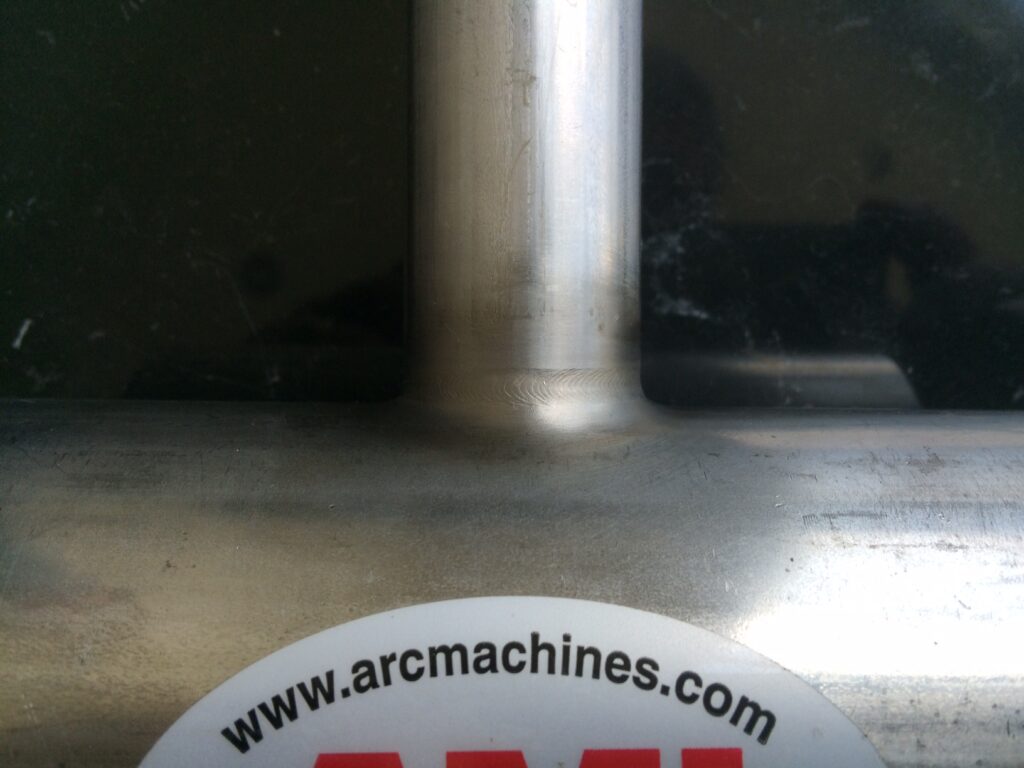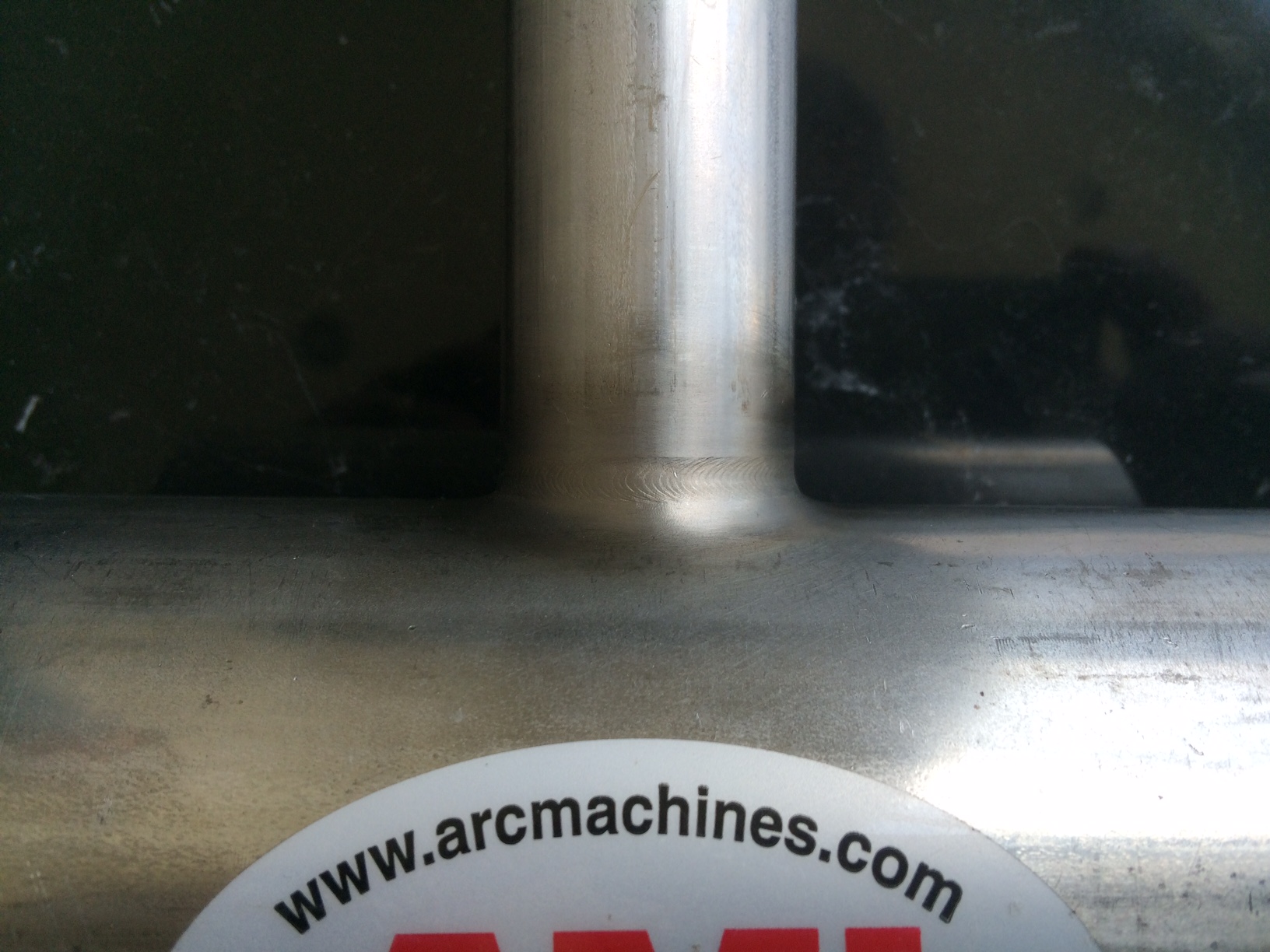
Tungsten inclusion is a welding defect found in gas tungsten arc welding (GTAW), also known as tungsten inert gas (TIG) welding. This welding process uses a non-consumable tungsten electrode to generate an arc—and a tungsten inclusion occurs when some of the material from this electrode is deposited into the molten puddle. This creates a discontinuity of a small piece of tungsten surrounded by steel, stainless steel, or another metal that is the base material of the workpiece.
Tungsten inclusion is a weld defect that can compromise the weld’s quality—especially in high-pressure piping systems. It can create a stress point that can cause failure of the weld under service loads. If they are too large, tungsten inclusions are grounds for rejecting a weld and necessitating costly reworking. Minimizing tungsten inclusions is vital in high-purity and high-specification welding. Testing for these inclusions and mitigating them is an essential element of meeting acceptable weld criteria.
Methods of Testing for Tungsten Inclusions
The most common method of finding tungsten inclusions is nondestructive testing (NDT), or testing that doesn’t compromise the weld, so it can be used if it is deemed acceptable. There is a range of nondestructive testing techniques, from visual inspection, visual inspection aides like dye penetrant testing, and using eddy current and magnetic fields to identify surface-level discontinuities. Testing for tungsten inclusions requires looking deep into the bead of a solidified weld, and only two NDT methods can accomplish this feat.
Radiographic Nondestructive Testing
Radiographic NDT uses X-rays that penetrate the surface of the metal. Traditionally, this sort of NDT has relied on film, but increasingly digital radiological testing has allowed near real-time scanning of welds and metal parts. Instead of film, the X-rays strike a sensitive metal plate. This reaction is interpreted by a computer and displayed on a screen. Tungsten inclusions are shown as bright white dots in the X-ray testing due to their density interfering with the passage of the X-rays.
Ultrasonic Nondestructive Testing
Ultrasonic or UT NDT uses a beam of sound waves transmitted to the workpiece through a coupling fluid to scan the interior of metals and welds. This beam can pass through metal largely unimpeded, except for certain discontinuities, which reflect far more of the soundwave than the surrounding metal. There are a range of different probes used to conduct ultrasonic scanning and a diverse range of software that are used to interpret the results. This means that how a tungsten inclusion appears can vary depending on the equipment used. UT NDT does also require a great deal of training to be used effectively. However, it does have the advantage of allowing the precise 3D position of a tungsten inclusion or other defect within the weld.
While they are a type of welding defect, a tungsten inclusion is not like a crack or a lack of fusion. Its presence isn’t grounds for automatic rejection of the weld. There are clearly defined acceptance criteria for inclusions in welds under standards from both the American Welding Society (AWS) and the American Society of Mechanical Engineers (ASME). AWS standards state that tungsten inclusions with a maximum dimension exceeding twenty percent of the material thickness or ⅛ inch, whichever is less (3.175 millimeters), should be rejected. ASME standards are similar, defining acceptance criteria as under 2.5 or 3 mm or ½ or ⅓ the material’s total width, whichever is less, depending on whether the weld will be performing under normal duty or severe cyclical duty.
While tungsten inclusions don’t form grounds for immediate rejection of the weld, the tolerances for a tungsten inclusion are tight. Mitigating a tungsten inclusion whose dimensions exceed the grounds for acceptance will likely be very expensive to rework—requiring, at a minimum, removal of the weld and the inclusions and rewelding. A time-consuming process that means starting with completely new materials might be more affordable. This means avoiding tungsten inclusions and other weld defects right from the start is important.
Preventing Tungsten Inclusions from GTAW Welding
The most common way to produce a weld with a tungsten inclusion is to crash the electrode into the molten metal during GTAW welding. This occurrence will almost certainly cause a tungsten inclusion that exceeds acceptance criteria and signals the immediate need for the weld to be reworked. Aside from this rather obvious error to be avoided, other important elements to avoid introducing tungsten inclusions are:
- Tungsten can withstand temperatures up to 3,380°C. However, welding arcs can reach temperatures of 6,093°C, and tungsten can crack well before it reaches its melting point. Welding temperatures need to be kept within the limits of a tungsten electrode’s heat tolerances.
- Burrs, cracks, and other imperfections in the surface of a tungsten electrode can reduce its structural integrity and make it vulnerable to melting or cracking due to heat. This can allow small pieces of the electrode to break up and end up in the weld.
- Arc length can also affect the possibility of tungsten inclusions. The shorter an arc is, the higher the heat on the electrode is. The electrode must be at a safe distance from the weld pool, minimizing the chances of contaminant transfer.
A significant factor in avoiding tungsten inclusion is using pre-ground diamond polished tungsten electrodes that reduce burrs and other surface imperfections that can encourage the formation of loose tungsten and lead to tungsten inclusions. Also, consider the tungsten grind angle. A symmetrical grind angle can help ensure the smooth dispersal of heat across the whole electrode, keeping it intact.
Finally, arc gaps are very important for preventing tungsten inclusions. In manual GTAW operations, this is determined by the skill of the welder, and even experienced welders can make mistakes, especially in very challenging operations like welding pipe or tube. Automation provides one of the surest guards against crashing the electrode into a weld creating tungsten inclusions. It also provides a very effective defense against other welding flaws and defects, as welding automation, like orbital welding, is a significantly more reliable process than manual welding.
Arc Machines Inc. is a leader in automated welding systems for pipe and tube orbital welding with precision ground diamond polished tungsten from Wolfram that prevents tungsten inclusions and other welding flaws and defects.
Contact us to find out more about high-quality tungsten electrodes and other orbital welding equipment from Arc Machines. To learn more about our products, contact sales@arcmachines.com. For service inquiries, contact service@arcmachines.com. Arc Machines looks forward to providing the equipment and services your project needs.





